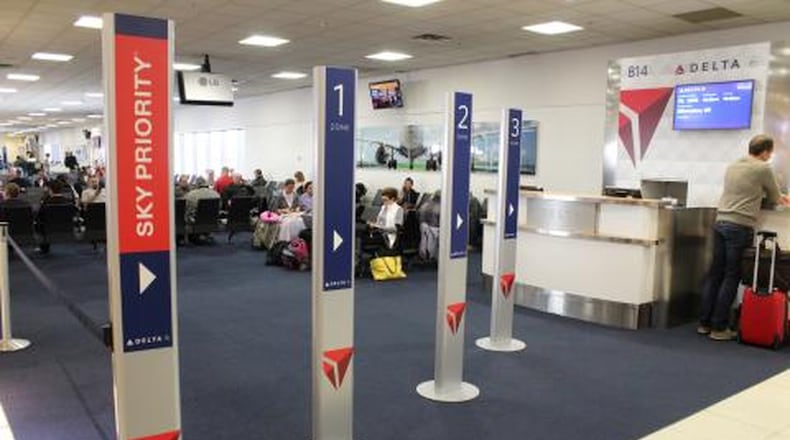One of the thorniest issues for any airline is how to get people onto planes in a quick and orderly way while also giving privileged status to those who spend the most.
It doesn’t help that flights on popular routes are often full these days, or that many passengers are schlepping carry-ons built to maximum dimensions.
The tension between crowd-handling efficiency and tiered service is one reason Atlanta giant Delta Air Lines is tweaking the boarding process at its home hub at Hartsfield-Jackson International Airport.
“It’s easing that crowd flow,” said Delta spokeswoman Ashton Morrow, who said boarding time is reduced by 30 to 60 seconds with the new system — a small-sounding but significant gain in an operation the size of Delta’s. At the same time, she added, “loyalty is still sort of how we’ve built our process. That’s definitely not changing.”
At five gates on Concourse B, Delta passengers line up in four parallel lanes at marked pillars. They will continue to board by zone.
The lanes are intended to instill some order in the waiting area and deter people from spilling into the busy walkway, the airline says.
They could also help reduce the number of “gate lice” — a frequent flier nickname for people who crowd near the jetway door long before their group is called, contributing to confusion and stress as those in earlier boarding groups try to find the line.
The lines also create a separate area for premium customers to line up separately, and do the same for passengers who need special assistance, according to Delta.
The move comes as Delta and other airlines further subdivide service levels, from elite high-milers in first class to upgraders in enhanced coach to bargain hunters using low-frill “basic economy” fares.
Not a commodity
“We don’t want to be viewed as a commodity,” Delta chief financial officer Paul Jacobson said during a recent investor presentation. Selling different tiers of fares and seats in different cabins “decommoditizes the product and ultimately redefines our focus point” to sell different levels of service instead of just a generic seat on a plane.
That focus is “not only through just the flight but through the boarding process” and other options, “whether you want to sit in first class on this trip by paying a first class upgrade fee, or you want priority boarding because you’ve got some important things in your carry-on and you want to ensure that there’s going to be carry-on space so you pay up for priority boarding,” Jacobson said.
The airline plans to install the pillars at the rest of its gates at Hartsfield-Jackson and to more airports if it continues to get good customer feedback. The new boarding process on Concourse B comes as Delta renovates its gate areas at Hartsfield-Jackson as part of a $6 billion modernization and expansion of the world's busiest airport.
Delta has tested a variety of boarding processes. Bill Lentsch, senior vice president of airport customer service, said that will continue.
The Atlanta airport offers a contrast in boarding processes, thanks to its No. 2 operator, Southwest Airlines. Southwest famously does not offer assigned seating.
It revamped its boarding process years ago by adding marked posts, similar to those now being adopted by Delta, to help organize passengers lining up to board. They are assigned to one of three boarding groups, but not to specific seats.
Some travelers say they like the Southwest boarding process more because it’s less hectic at the gate — despite the lack of assigned seats once inside the plane.
Boarding is crucial for airlines because it affects both the customer experience and operations. Logjams at the gate can cause delays that ripple throughout the system.
The ‘hold room’ feel
Delta aims to “take the ‘hold room’ feel out of the gate space” and is “looking at different options to make the gate area more engaging,” according to Morrow.
Delta and other airlines with assigned seating have tried different methods of boarding over the years, with variations of back-to-front, outside-in (also known as WilMA, or window-middle-aisle) or other methods.
For passengers who have been stuck in a line to board that seems to stall interminably, it’s tempting to question the judgment of those who developed the boarding process.
But more factors come into play than just how quickly the plane can be boarded.
“We really put boarding under a microscope,” including the process and communication to customers with signs, said Morrow, the Delta spokeswoman.
Beyond the lineup pillars, the airline has also installed signage at the boarding door — “where you would naturally look at the gate,” Morrow said — showing what group is boarding. That means people arriving from connecting flights can quickly get into the flow without having to ask another passenger or the gate agent.
Delta says a priority is keeping its elite frequent fliers feeling elite. Medallion SkyMiles members — often business travelers — can still board whenever they want during the process.
Boarding early is seen as more of a perk due to tight space in overhead bins — caused in part by the airlines’ decision to charge for checked baggage. (Southwest is the exception.) Getting aboard early gives passengers a better shot at carry-on space.
Delta and other airlines typically give early boarding to priority customers regardless of where they are seated. But “cutting” the line without a clear reason can lead to conflicts between passengers.
Delta already had a special lane for “Sky Priority” boarding. With the new process as well, “that premium line can be accessed at any point during the process,” Morrow said.
About the Author
Keep Reading
The Latest
Featured



